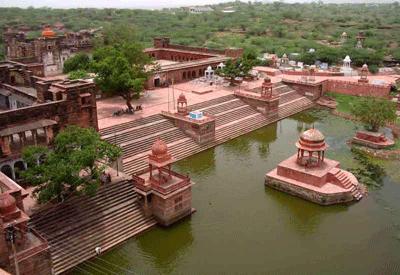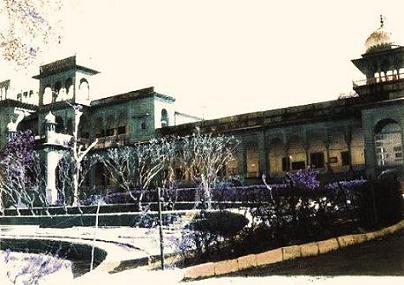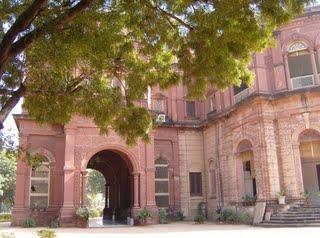
History of dholpur dholpur is a city in eastern most parts of the Rajasthan state of India. It is the administrative headquarters of dholpur District. dholpur was a part of Bharatpur district. dholpur became a separate district in 1982 comprising four tehsils of Bharatpur namely dholpur, Rajakhera, Bari and Baseri. It is bordered by Bharatpur district of Rajasthan and Uttar Pradesh to the north, Madhya Pradesh to the south, Karauli district to the west and Uttar Pradesh and Madhya Pradesh to the east. dholpur is situated between Agra and Gwalior (each about 55 Kilometres away from dholpur) and is 250 Kilometres away from Delhi. It is on the main Central Railway track and the National Highway No.3 on Delhi- Bombay Road. At its railway station, the town name is spelled "Dhaulpur". dholpur according to the Epics was initially known as Dhawalgiri and later on Dhaulagir, and now as dholpur. Before the battle of Mahabharat this whole area was under the Yadavs. Whose different branches were spread over the entire area extending from the south of the river Chambal. Col. James Todd in his book Annals and Antiquities of Rajputana has mentioned that the area was submerged under sea during the Ramayan period. The key to the ancient history of dholpur is the ruins of strength fort which is situated on the bank of river Chambal. During the second phase of ancient history, the ruins of Mahabharat period could be seen and around the temple of Muchukund ji. According to the Shastras Muchukund was a very illustrious king before Krishna. During the war between Devtas and Danavas, King Muchukund sided with the devtas and was instrumental in their victory. Indra was so pleased was that he asked Muchukund to have a boon. Muchukund was so tired that he asked Indra to allow him to sleep peacefully and if anyone should wake him up, Muchukund's angry gaze would burn him to ashes. Mahabharat reveals that during one of the battles with the demons Krishna came to the spot where Muchukund was sleeping. He put his pitamber on the sleeping Muchukund. The demon thinking him to be Krishna woke him up, and thus the demon was burnt to ashes, and thus the life of Krishna was saved. The event took place, in a spot very near to the Muchukund Ji's temple, where the ruins of old palaces still exist. The appearance of these, however does not seem to be that old.  During the Buddha's period It is a known fact (citation needed) that during Buddha's time there were sixteen Maha Janpads in Bharatvarsh. dholpur at that time was included in Matsya Janpad. During the Mauryan rule it was included in the Mauryan Empire. From Gupta period to the arrival of Chinese traveler Huansuang Bharatpur, Karauli and dholpur were a part of Mathura Janpad. Around 8th the 10th century, Chauhans ruled over it. During the 10th century the Jats took over. In the year 1194 it remained under Mohammed Gauri. During 8th and 11th century many Rajput and Jat rulers settled in Rajputana, a foundation of an independent Jat state was laid. Its founder was Tej Singh. His ancestors were from Bamrauli, therefore, the rulers were known as Bamraulia, Maharaja Mansingh Tomar of Gwalior bestowed upon the rulers of dholpur the title of Rana and since then the rulers are known as Rana. During Sultans Any invader, who wished to capture Gwalior and Malwa, had to pass through dholpur. In the year 1489 Bahlol Lodi before fighting with Gwalior king, faced the forces of the ruler of dholpur. During the year 1502 Sikandar Lodi had to fight with dholpur King Vinayak Dev for about a year and then with great difficulty was successful in defeating him and capturing dholpur. Thus dholpur came into prominence and bore the brunt of all the invading forces of the North Realising the strategic and geographical importance. It was Sikandar Lodi who first thought of having a military cantonment at Agra which was a small village under Bayana and at dholpur in the year 1504, so that he could successfully carry out military designs against Gwalior and Malwa region. dholpur being situated on the banks of the river Chambal was considered sate for the establishment of military cantonment and forts, during the medieval period. According to the 'Tawarikh Shershahi' and 'Babarnama' written by their courtiers, the credit for the construction of the Shergarh for goes to Shershah Suri.  Mughal Period After the famous battle of Panipat, Babar became the first Mughal ruler of Hindustan. His rule was not a bed of roses in the early years of his reign. After the death of Ibrahim Lodi Many states declared themselves independent. Talai Khan became the ruler of Gwalior. Similarly, Mohammed Jaifoon declared himself the ruler of dholpur. Babar sent Junniad Barlas to dholpur, who crushed the rebellion and took over the administration of dholpur in his own hands. dholpur was famous for its natural beauty, dense forests and ample games that attracted the royal princes regularly visiting this region during Mughal period. According to 'Humayunnama' Babar once took all his wives and consorts to dholpur on the death of his son Anwar Mirza for a change. Not only that, the beauty of dholpur fascinated Akbar so much that he constructed the palaces at Khanpur on the banks of Talab-shahi near Bari. According to legends he constructed these palaces to make this place his capital. Later, on being offended by the residents, he left them and founded Fatehpur Sikri. The incident which paved, the way for Aurangzab's stability occurred at the place which sealed that fate of Dara Shikoh. Once dholpur also became, a matter of dispute between Shahjahan and Noorjahan, Shahjahan once requested Emperor Jehangir to give him the pargana of dholpur. Shahjahan taking it for granted that the Emperor would give his consent sent his faithful officer to dholpur. On the other hand, Nur Jahan had already acquired the Paragana of dholpur for prince Shahryar. She deputed Sharif-ul-Malik to take charge of the administration. There was a clash between the two, in which, Sharif-ul-Malik had an eye injury and many persons died in the skirmish . For this act of insolence Shahjahan was reprimanded and was asked to send his troops from the South to Agra immediately. |

